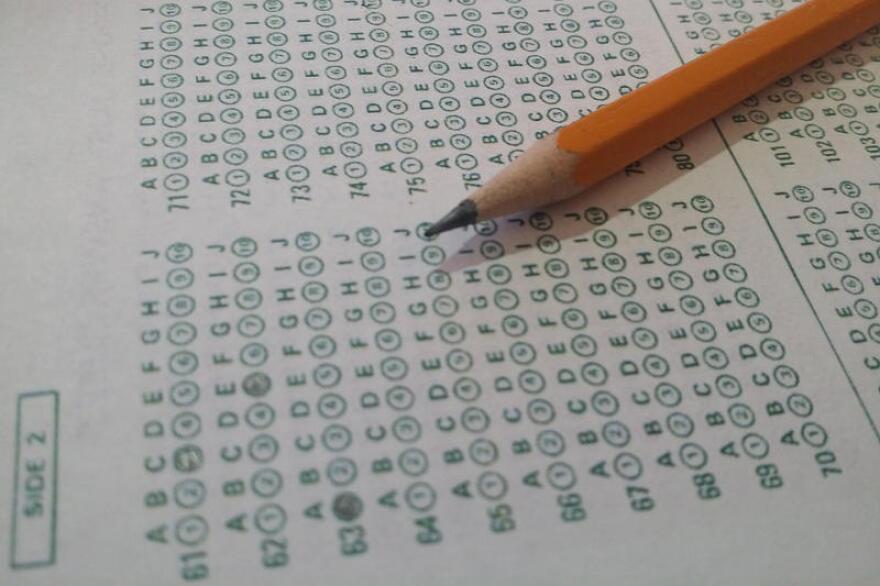New SAT results showed more Hoosier students meeting college-readiness benchmarks in reading, but overall scores remain low — especially in math.
More than 81,000 Indiana high school students took the test in 2024-25. Most of those were juniors — students slated to graduate in spring 2026.
Results showed slight improvement on the SAT this year in both the evidence-based reading and writing and math sections.
In reading and writing, the share of students scoring at or above the college-ready threshold rose to 54.5%, up from 51.8% the year before and 50.5% in 2023.
Bloomington South High School had 75.4% reach the threshold and Bloomington North had 62.5%.
A greater number of students continued to score in the “below college-ready” category for math, however. Just 25.2% of test-takers earned passing scores in 2025.
Bloomington South High School had 53.5% reach the threshold and Bloomington North had 38.4%.
About 24.5% of Indiana students who took the SAT during the last academic year met the readiness benchmark on both subject portions, according to the Indiana Department of Education. That’s a 0.3% increase compared to last year, but still 4% down from 2023.
Bloomington South High School had 51.9% reach the threshold and Bloomington North had 37.5%.
“We still have a large number of students in that below-college-ready group,” said Lynn Schemel, IDOE’s chief academic officer. “We want to move that … in the (right) direction … but we have more work to do.”
The new test results were released last week and discussed by the State Board of Education. Data from the latest round of ILEARN testing was also published.
State law requires IDOE to administer a national college entrance exam to high school students before graduation.
How scores work
The SAT includes math, reading and writing sections. The assessment, administered by the College Board, scores students as “At College-Ready,” “Approaching College-Ready,” or “Below College-Ready,” depending on their performance.
A student who scores “Approaching” with one more year remaining in high school is expected to be at “At College-Ready” by graduation.
Students who score at or above the benchmark have a 75% chance of earning at least a C in their first semester of credit-bearing college courses in that subject area, IDOE officials said.
Of the 81,620 students who took the reading and writing assessment in 2025, more than half met the college-ready benchmark. About 36.4% of students were approaching a passing score, while 9.2% remained below.
In math, 21.6% of students were “approaching” college-readiness, and 53% were below the readiness benchmark.
That’s a decline from 2024, when roughly 52.8% of test-takers were below college-ready levels, and from 45.2% who trailed the benchmark in 2023.
About 25% of students posted college-ready math scores in 2024. IDOE data indicates 30.7% of students who took the SAT were college-ready in math in 2023.
“(The latest data) underscores the urgency of the work we’re doing,” Schemel said, referencing new instructional resources and educational screeners designed to improve foundational math skills.
The state, she noted, is currently building math support systems for students in grades K–2 and 9–12 to mirror recent literacy investments made for elementary and middle school grades.
Board members weigh in
Board members acknowledged the need for additional math support, but some questioned whether the SAT is the right tool to evaluate all progress among all Indiana students, especially those not planning to attend college.
“This is a college-ready exam, and we administer it to students who aren’t going to college,” said board member B.J. Watts. “Let’s be honest — it’s not important to them. That doesn’t mean they don’t have other skills where they shine. But that’s not going to show up here, at least not yet.”
Indiana ILEARN scores show continued growth in math — but reading levels stay flat
Indiana Education Secretary Katie Jenner echoed the need for continued discussion.
“As a board, we’ve talked a lot about what skills students need in high school,” Jenner said. “Does the SAT fit that? I think that’s a conversation we’ll continue to have.”
Education officials further pointed to a wave of reforms aimed at supporting students earlier in their education, like numeracy screeners, teacher training in evidence-based instruction methods, and math intervention plans.
All of those efforts are still ramping up, Schemel said.
“We’re trying to wrap our arms around the standards at the high school level now, too,” Hurst said. “That includes what students are getting in their courses before they even get to this SAT moment.”
Jenner added that SAT scores are likely to evolve more as Indiana rolls out new pathways to graduation.
Under the state’s new high school diploma model — which is set to take effect for all schools by 2029 — all juniors will still be required by law to take the SAT, but scores are only used toward graduation if a student chooses that option under one of the college-bound or employment-readiness tracks, or “seals.”
“We’re maximizing the four years of high school,” she said. “Whether students pursue enrollment, enlistment or employment, our work has to prepare them for all three.”
GET THE MORNING HEADLINES.SUBSCRIBE Indiana Capital Chronicle is part of States Newsroom, a nonprofit news network supported by grants and a coalition of donors as a 501c(3) public charity. Indiana Capital Chronicle maintains editorial independence. Contact Editor Niki Kelly for questions: info@indianacapitalchronicle.com.


